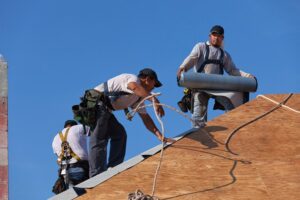
When it comes to commercial buildings, having a sturdy and durable roof is essential. Over time, wear and tear can take a toll on your roof, leading to leaks, cracks, and other issues that compromise its integrity. In such cases, it becomes crucial to consider roof replacement as a viable solution. Understanding the signs that indicate the need for replacement, the different roofing materials available, and the replacement process itself are all important factors to consider. This article will provide valuable insights into Bartlett commercial roofing replacement, helping you make informed decisions for your business.
Understanding the Need for Roof Replacement
There are various signs that indicate your commercial roof is in need of replacement. Ignoring these signs can lead to more serious problems down the line. One of the most obvious signs is the presence of leaks. If you find water seeping into your building or notice water stains on the ceiling, it’s a clear indication that your roof needs attention.
In addition to leaks, other signs include missing or broken shingles or tiles, excessive wear and tear, and noticeable sagging. You may also experience increased energy costs due to poor insulation resulting from an aging roof.
Signs Your Commercial Roof Needs Replacement
It’s important to be proactive and recognize the signs that indicate your commercial roof needs replacement. These signs may include:
- Widespread shingle or tile damage
- Visible sagging or bowing
- Multiple roof leaks
- Frequent repairs
- Decreased energy efficiency
If you notice any of these signs, it’s essential to consult a roofing professional to assess the condition of your roof and recommend the best course of action.
The Lifespan of Commercial Roofs
The lifespan of a commercial roof depends on various factors, including the type of roofing material, climate conditions, maintenance, and installation quality. On average, most commercial roofs last between 20 to 30 years. However, proper maintenance can significantly extend the lifespan of your roof. Regular inspections, prompt repairs, and routine maintenance can make a significant difference in the performance and longevity of your roof.
Choosing the Right Roofing Material
When it comes to commercial roof replacement, choosing the right roofing material is crucial. The material you select should align with your business needs, budget, and aesthetic preferences. It should also be durable, weather-resistant, and energy-efficient.
Comparing Different Roofing Materials
There is a wide range of roofing materials available for commercial use, each with its own set of advantages and disadvantages. Here are some popular options:
- Asphalt Shingles: Affordable and easy to install, asphalt shingles are a common choice for commercial buildings.
- Metal Roofing: Known for its durability and longevity, metal roofing is a popular option that can withstand harsh weather conditions.
- TPO Roofing: Thermoplastic Olefin (TPO) is a cost-effective option that offers excellent energy efficiency.
- EPDM Roofing: Ethylene Propylene Diene Monomer (EPDM) is a synthetic rubber material that provides superior durability and resistance to UV rays.
- PVC Roofing: Polyvinyl Chloride (PVC) roofing is known for its exceptional longevity and resistance to chemicals.
It’s important to consult with a professional roofing contractor to determine which material best suits your specific needs.
Factors to Consider in Material Selection
When choosing a roofing material, several factors should be taken into account:
- Climate and weather conditions of your location
- Budget and long-term cost considerations
- Building design and aesthetics
- Maintenance requirements
- Energy efficiency and sustainability goals
Considering these factors will help you make an informed decision and select the roofing material that best meets your requirements.
The Roof Replacement Process
Replacing a commercial roof involves a series of steps to ensure a smooth and successful installation. Understanding the process will help you prepare and set realistic expectations.
Initial Roof Inspection and Assessment
Prior to the replacement process, a professional roofer will conduct a thorough inspection of your existing roof. This assessment will help identify any underlying issues and determine the scope of the replacement project.
The inspector will check for signs of damage, measure the square footage of the roof, and assess the condition of the underlying structure. Based on this evaluation, they will provide you with a detailed report outlining the recommended course of action.
Removing the Old Roof
Once the inspection is complete, the first step in the replacement process is removing the old roof. This involves safely and efficiently removing the existing materials, such as shingles or tiles. The removal process is crucial to ensure that the new roof can be properly installed.
The removal process may also involve addressing any underlying issues, such as water damage or rot, before installing the new roof.
Installing the New Roof
After the old roof is removed, the next step is installing the new roof. This involves a series of tasks, including laying down the underlayment, installing the roofing material, and ensuring proper ventilation and insulation.
A professional roofing contractor will ensure that the installation is done according to industry standards and local building codes. They will also take steps to minimize disruptions to your business operations during the installation process.
Cost and Time Considerations for Roof Replacement
When planning for commercial roof replacement, it’s important to consider the cost and time required for the project. Understanding these considerations will help you budget and plan accordingly.
Estimating the Cost of Roof Replacement
The cost of roof replacement can vary depending on various factors, including the size of the roof, the roofing material selected, the complexity of the project, and any additional requirements, such as insulation or ventilation upgrades.
It’s recommended to obtain quotes from multiple roofing contractors to get a clearer understanding of the costs involved. Keep in mind that while price is an important factor, quality and expertise should also be considered when selecting a contractor.
Timeline for Commercial Roof Replacement
The timeline for commercial roof replacement can vary based on the size and complexity of the project. Factors such as weather conditions and the availability of materials can also impact the timeline.
A professional roofing contractor will provide you with an estimated timeline for completion before starting the project. It’s important to maintain open communication and discuss any potential delays or schedule adjustments during the process.
Maintenance Tips for Your New Roof
While a new commercial roof can provide years of protection, it’s important to properly maintain it to maximize its lifespan and performance. Regular inspections and preventive maintenance measures play a crucial role in keeping your roof in optimal condition.
Regular Roof Inspections
Scheduling regular inspections is vital to detect and address any potential issues before they become major problems. A professional roofer can conduct thorough inspections and provide you with recommendations for maintenance or repairs.
Inspections should be conducted at least twice a year, ideally during spring and fall, as well as after severe weather events.
Preventive Maintenance Measures
Implementing preventive maintenance measures can help extend the lifespan of your commercial roof. This may include cleaning the gutters regularly, removing debris, and trimming nearby trees to minimize the risk of damage during storms.
Additionally, ensuring proper ventilation and insulation, addressing any leaks promptly, and keeping the roof free of debris can all contribute to the longevity and performance of your roof.
By following these maintenance tips and staying proactive, you’ll be able to safeguard your investment and enjoy the benefits of your new commercial roof for years to come.
Ready to secure the longevity and integrity of your commercial roof with a trusted partner at your side? Look no further than Commercial Roofing Rana, where our commitment to excellence has protected businesses across the Mid-South since 1983. From industrial complexes to shopping centers, our Duro-Last roofing systems offer the perfect fit and superior protection against the elements. Don’t let the next storm catch you unprepared. Schedule Now with our licensed team of experts and ensure your property is in top condition for years to come.
